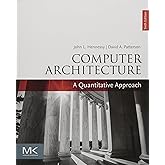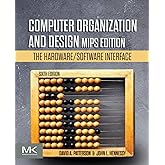
Download the free Kindle app and start reading Kindle books instantly on your smartphone, tablet, or computer - no Kindle device required.
Read instantly on your browser with Kindle for Web.
Using your mobile phone camera - scan the code below and download the Kindle app.

Follow the author
OK
Computer Organization and Design RISC-V Edition: The Hardware Software Interface (The Morgan Kaufmann Series in Computer Architecture and Design) 1st Edition
The new RISC V Edition of Computer Organization and Design features the RISC V open source instruction set architecture, the first open source architecture designed to be used in modern computing environments such as cloud computing, mobile devices, and other embedded systems.
With the post PC era now upon us, Computer Organization and Design moves forward to explore this generational change with examples, exercises, and material highlighting the emergence of mobile computing and the Cloud. Updated content featuring tablet computers, Cloud infrastructure, and the x86 (cloud computing) and ARM (mobile computing devices) architectures is included.
An online companion Web site provides advanced content for further study, appendices, glossary, references, and recommended reading.
- Features RISC V, the first such architecture designed to be used in modern computing environments, such as cloud computing, mobile devices, and other embedded systems
- Includes relevant examples, exercises, and material highlighting the emergence of mobile computing and the cloud.
- ISBN-100128122757
- ISBN-13978-0128122754
- Edition1st
- PublisherMorgan Kaufmann
- Publication dateApril 27, 2017
- LanguageEnglish
- Dimensions7.5 x 1.25 x 9 inches
- Print length696 pages
There is a newer edition of this item:
$69.28
(60)
Only 15 left in stock - order soon.
Customers who viewed this item also viewed
Editorial Reviews
Review
Covers relevant examples, exercises, and material highlighting the emergence of mobile computing and the cloud
About the Author
ACM named John L. Hennessy a recipient of the 2017 ACM A.M. Turing Award for pioneering a systematic, quantitative approach to the design and evaluation of computer architectures with enduring impact on the microprocessor industry. John L. Hennessy is a Professor of Electrical Engineering and Computer Science at Stanford University, where he has been a member of the faculty since 1977 and was, from 2000 to 2016, its tenth President. Prof. Hennessy is a Fellow of the IEEE and ACM; a member of the National Academy of Engineering, the National Academy of Science, and the American Philosophical Society; and a Fellow of the American Academy of Arts and Sciences. Among his many awards are the 2001 Eckert-Mauchly Award for his contributions to RISC technology, the 2001 Seymour Cray Computer Engineering Award, and the 2000 John von Neumann Award, which he shared with David Patterson. He has also received seven honorary doctorates.
Product details
- Publisher : Morgan Kaufmann; 1st edition (April 27, 2017)
- Language : English
- Paperback : 696 pages
- ISBN-10 : 0128122757
- ISBN-13 : 978-0128122754
- Item Weight : 3.05 pounds
- Dimensions : 7.5 x 1.25 x 9 inches
- Best Sellers Rank: #898,069 in Books (See Top 100 in Books)
- #33 in Computer Hardware Design
- #59 in Microprocessor Design
- #172 in Computer Hardware Design & Architecture
- Customer Reviews:
About the author

Discover more of the author’s books, see similar authors, read book recommendations and more.
Customer reviews
Customer Reviews, including Product Star Ratings help customers to learn more about the product and decide whether it is the right product for them.
To calculate the overall star rating and percentage breakdown by star, we don’t use a simple average. Instead, our system considers things like how recent a review is and if the reviewer bought the item on Amazon. It also analyzed reviews to verify trustworthiness.
Learn more how customers reviews work on AmazonTop reviews from the United States
There was a problem filtering reviews right now. Please try again later.
- Reviewed in the United States on May 14, 2018I don't understand the negative reviews. This is a very nicely written textbook (from a second year undergrad with only some familiarity with logic design). Explains everything crystal clear and shows motivation for everything. This is a good textbook to learn from as it is very pleasant to read and will improve your understanding of computer organization/assembly.
- Reviewed in the United States on October 24, 2017Ignore the 1 star review. Regardless of whether there's a lot updated from the previous version, the book is a great introduction to RISC-V.
- Reviewed in the United States on December 17, 2017Great introduction to RISC-V. Unfortunate that it does not include an answer key to the exercises.
- Reviewed in the United States on November 6, 2018A+++
- Reviewed in the United States on March 14, 2019If you didn't have logic background, authors included an Appendix section and it does a really good job at explaining all the concepts.
The normal chapters also do a great job explaining everything. The book also has many graphs and visual, which make it easy to understand the concepts.
- Reviewed in the United States on July 3, 2022This is terribly written, and it doesn't seem like anybody edited it. The end of chapter exercises are so obscure about what data you are supposed to use that it's almost impossible to work through. Without looking the answers up from a 3rd party source and working backwards you will never be able to solve all of the exercises. I can not believe my university actually approved this textbook.
- Reviewed in the United States on May 1, 2021I have never seen so many typos in a textbook. It's the first edition, so some are expected, but there's a lot.
As for the material itself, it's naturally dry. Some parts have good explanations, others read like a reference book rather than being instructional.
Overall, this series has potential in future editions, but as it stands, I would pick up something else.
- Reviewed in the United States on November 14, 2020Good book about computers in general. Very little information about Risc-V, however, although it does have ARM and X86 specific information. I was looking for a good book on Risc-V. Still looking.
Top reviews from other countries
-
 Iván LópezReviewed in Mexico on August 17, 2017
Iván LópezReviewed in Mexico on August 17, 20174.0 out of 5 stars Gran libro. Edición mejorable.
Lo bueno:
El libro está perfectamente redactado y es ideal para un primer curso de arquitectura de computadoras. Aunque en sus apendices explica nociones básicas de Diseño Digital, es bueno tener ya algunas nociones y práctica en estos temas, así como en aritmética de computador y quizá tener cierta experiencia programando en ensamblador. Nada que ningún Universitario no posea.
Lo malo:
En el libro físico no vienen incluidas varias secciones y apéndices que se dejan para una versión online. Tales como breviarios históricos y temas avanzados, y es una lástima porque hay secciones del libro físico que hacen referencia a las secciones online.
 G.A.Reviewed in France on November 25, 2018
G.A.Reviewed in France on November 25, 20185.0 out of 5 stars Inclusive
Very good reference book to get into hardware/software relationships regarding performance










